|
Home of the Old Ammo Guy's Virtual
Cartridge Trading Table
Picture Page
January 2018
Please note: Unless otherwise
indicated, the pictures on this web site are my property, and should not
be used by anyone without crediting the source.
Pakistani .410 Single Ball Enfield Musket Cartridges........
In the last couple of years 180 round wood crates of Pakistani
.410 single ball cartridges have become fairly common here in the United
States. Referred to by the British as a 'half case', these crates are tiny
by crate standards, measuring just 8 1/2" x 6 7/8" x 5 1/8". Though small,
they are constructed about as securely as a Brinks armored truck, which seems a
waste since the full crate weighs just over 14 pounds, and several could
easily be picked up at once and carried off by someone bent on stealing the
cartridges inside.
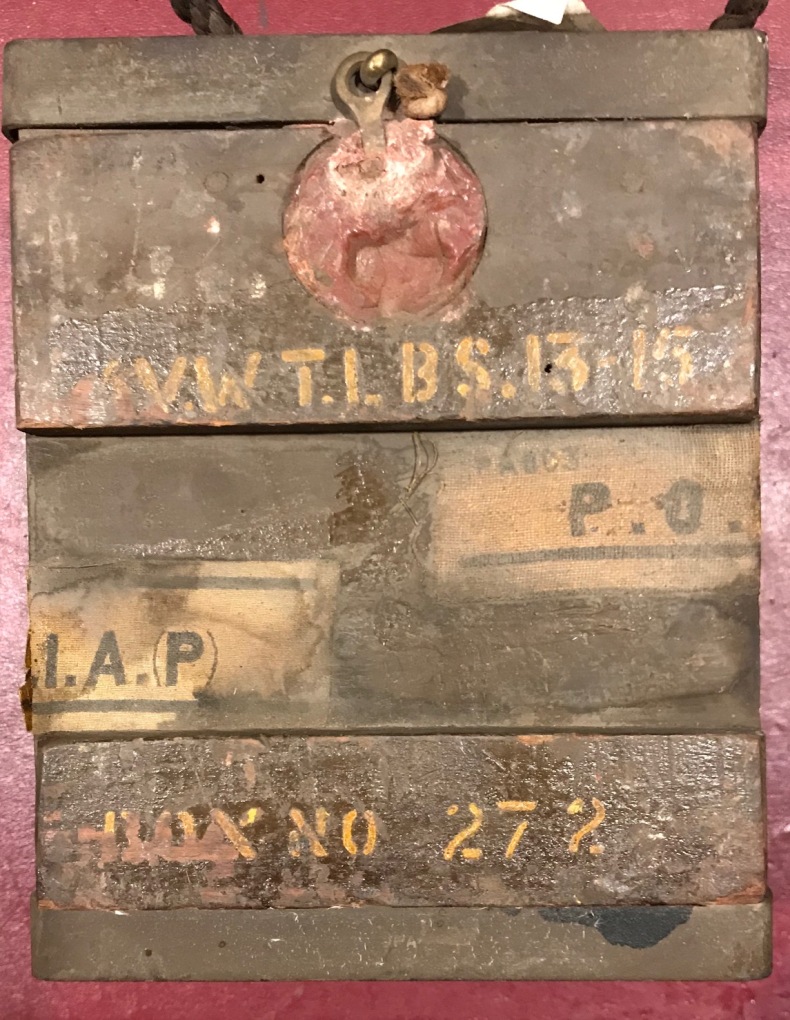 Nonetheless,
a couple of anti-tamper measures are used on the crate that will provide an indication that it has been opened. These are shown in the photo
here and the two just below. The first of these anti-tamper measures is a plug of a red
crumbly plastic-ish material (wax?) that fills a shallow 1.75" diameter hole
drilled into the top of the crate. It secures a brass latch-like arm which
is attached to one of two metal straps that hold the ends of top of the
crate securely in place. Once the red plug is broken, the arm is Nonetheless,
a couple of anti-tamper measures are used on the crate that will provide an indication that it has been opened. These are shown in the photo
here and the two just below. The first of these anti-tamper measures is a plug of a red
crumbly plastic-ish material (wax?) that fills a shallow 1.75" diameter hole
drilled into the top of the crate. It secures a brass latch-like arm which
is attached to one of two metal straps that hold the ends of top of the
crate securely in place. Once the red plug is broken, the arm is
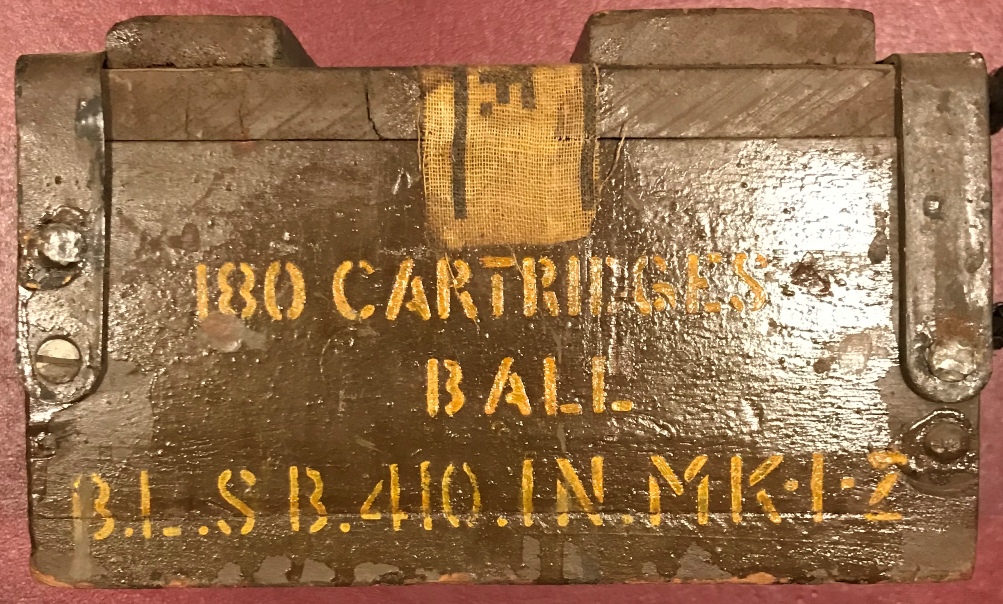 freed
and the end strap that it is attached to can be pivoted outward, freeing
that end of the top and allowing the lid to slide out from under the
other end strap. In the process of removing the top, two strips of cloth,
one attached to each end of the top and a short distance down each side of
the crate, would have to be cut or would tear freed
and the end strap that it is attached to can be pivoted outward, freeing
that end of the top and allowing the lid to slide out from under the
other end strap. In the process of removing the top, two strips of cloth,
one attached to each end of the top and a short distance down each side of
the crate, would have to be cut or would tear
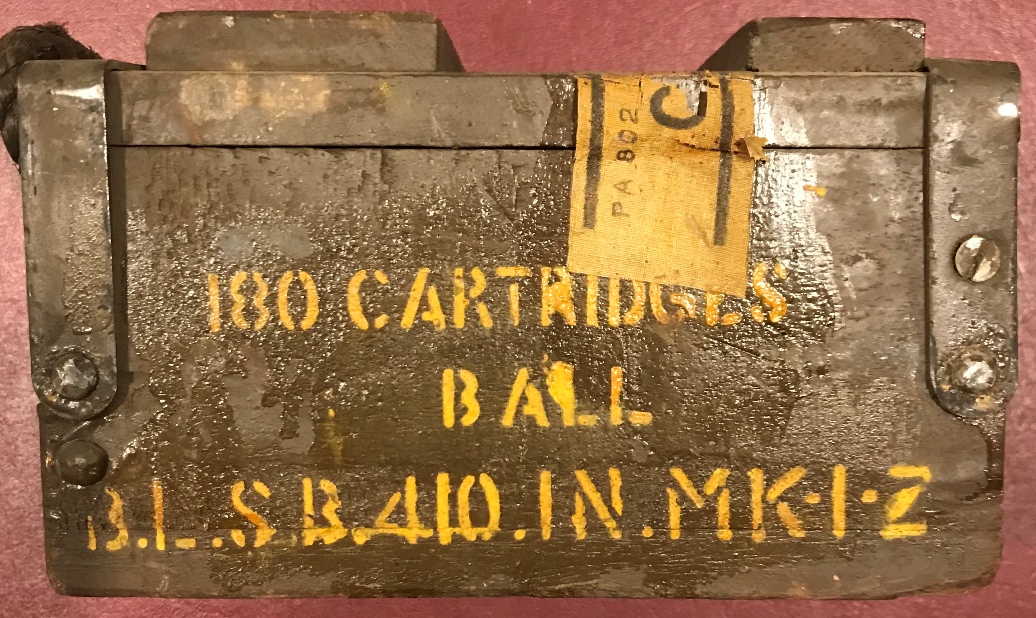 free,
providing another indication that the crate had been opened. These cloth
strips are
white; one
is marked in black PA802 C.I.A.(P), and the other is marked in black PA803 P.O.F..
I'm not sure what the C.I.A.(P) is, but the P.O.F. indicates the ammunition
was produced at the Pakistani Ordnance Factories. free,
providing another indication that the crate had been opened. These cloth
strips are
white; one
is marked in black PA802 C.I.A.(P), and the other is marked in black PA803 P.O.F..
I'm not sure what the C.I.A.(P) is, but the P.O.F. indicates the ammunition
was produced at the Pakistani Ordnance Factories.
Stenciling in yellow paint is applied the top, both sides,
and one end of the crate. Stenciling on the first photo above is pretty
self-explanatory; AV.WT.LBS.14-15 meaning average weight in pounds is 14 to
15 (pounds), and BOX NO 272. This crate weighs 14.5 pounds. The sides are shown in the next two
photos above; both are stenciled 180 CARTRIDGES / BALL /
B.L.SB.410.IN.MK-I-Z. The bottom line of the side stenciling is interpreted
as breech-loading single ball .410 version Mark I
using nito-cellulose powder (Z).
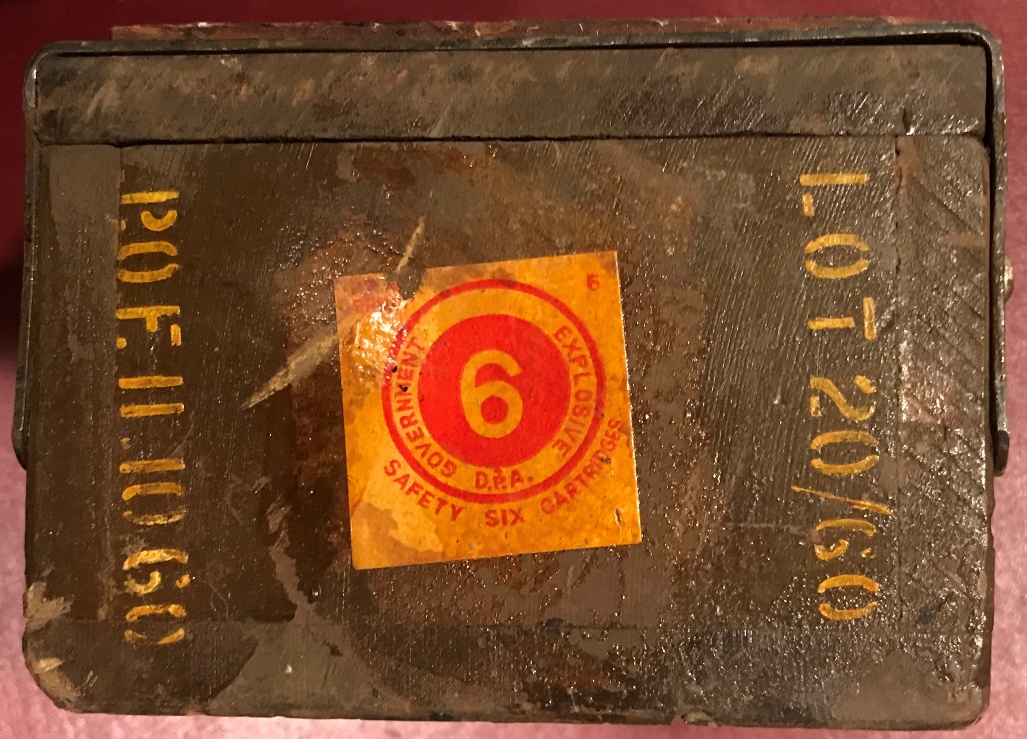 One end end of the crate is stenciled LOT 20 / 60, which
would mean that this is the 272nd box (as stenciled on top of the crate)
from the 20th of 60 lots of this ammunition. The highest numbered crate I
have seen in my Googling the internet was 571. Also stenciled on that end is
P.O.F. 11.10.60 which indicates the crate was packed at the Pakistani
Ordnance Factories on 11 October, 1960. The attached label with the 6 in a
red ball I assume is an explosives classification. The label is marked
GOVERNMENT EXPLOSIVE D.P.A. (with a British broad arrow mark over the P),
and SAFETY S One end end of the crate is stenciled LOT 20 / 60, which
would mean that this is the 272nd box (as stenciled on top of the crate)
from the 20th of 60 lots of this ammunition. The highest numbered crate I
have seen in my Googling the internet was 571. Also stenciled on that end is
P.O.F. 11.10.60 which indicates the crate was packed at the Pakistani
Ordnance Factories on 11 October, 1960. The attached label with the 6 in a
red ball I assume is an explosives classification. The label is marked
GOVERNMENT EXPLOSIVE D.P.A. (with a British broad arrow mark over the P),
and SAFETY S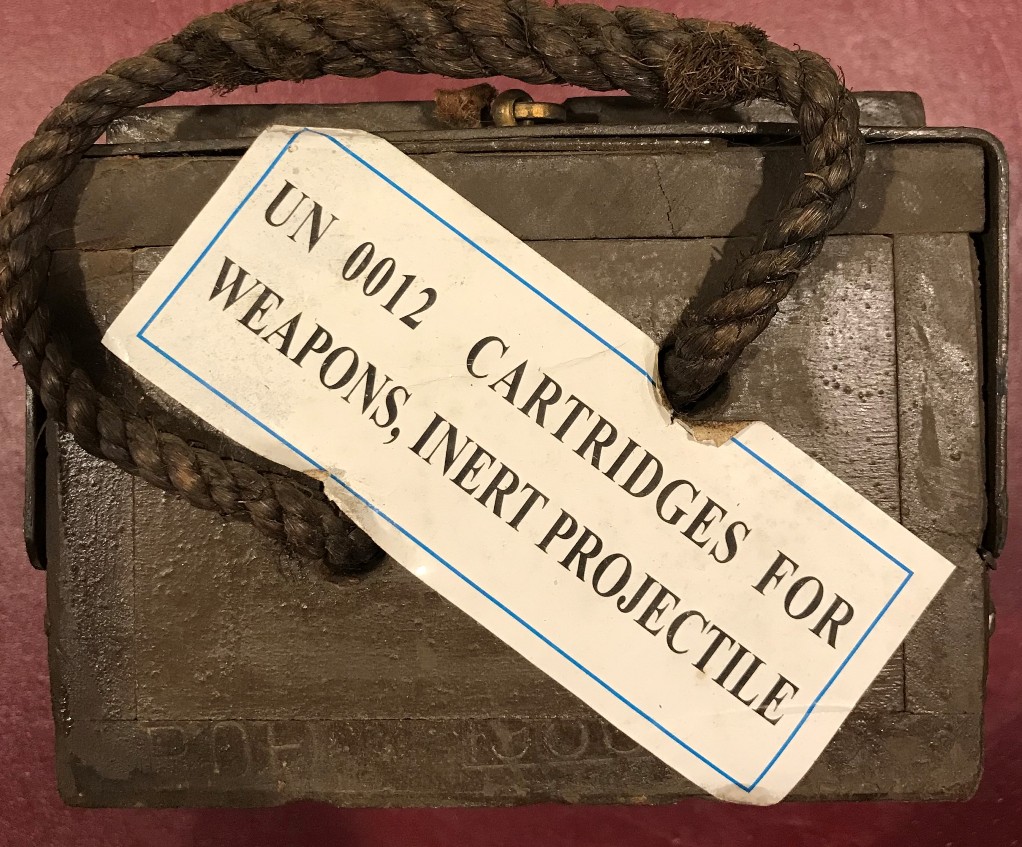 IX
CARTRIDGES. The other end of the crate was originally unmarked, but has had
a white
import label attached for shipping purposes, indicating the contents are
United Nations dangerous explosive materials category 12 - cartridges for
weapons, inert projectiles. IX
CARTRIDGES. The other end of the crate was originally unmarked, but has had
a white
import label attached for shipping purposes, indicating the contents are
United Nations dangerous explosive materials category 12 - cartridges for
weapons, inert projectiles.
Once opened, the crate will be found to contain a tin with
a
handle attached. A label on the tin provides instructions for opening it;
TAKE hold of the wire loop (handle) and
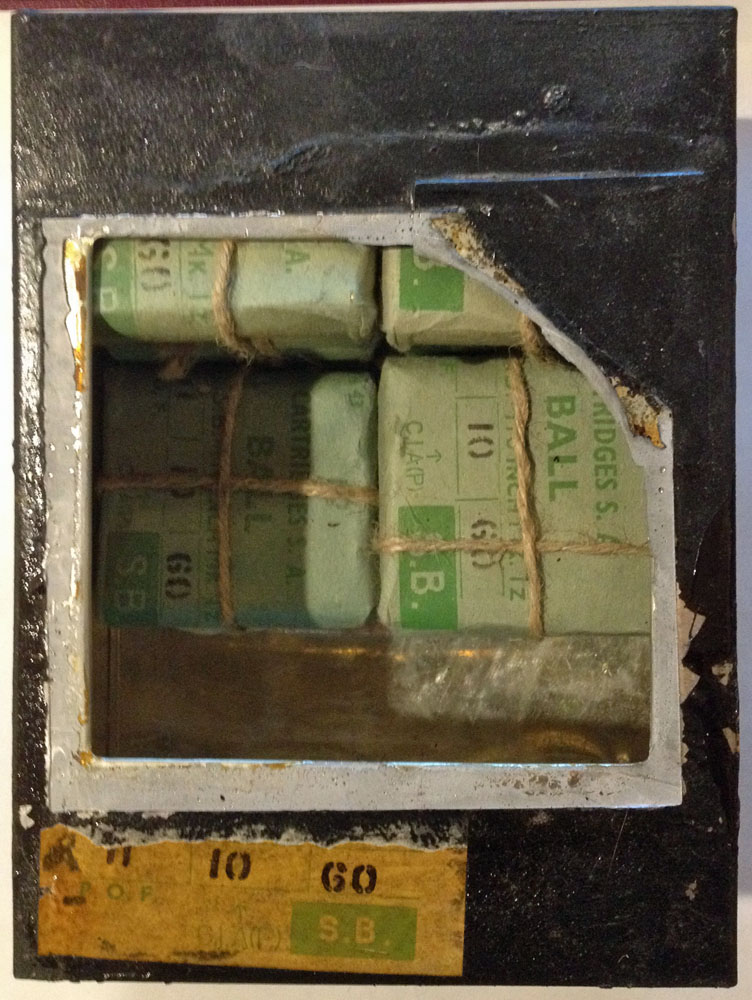 tear
off the lid tear
off the lid
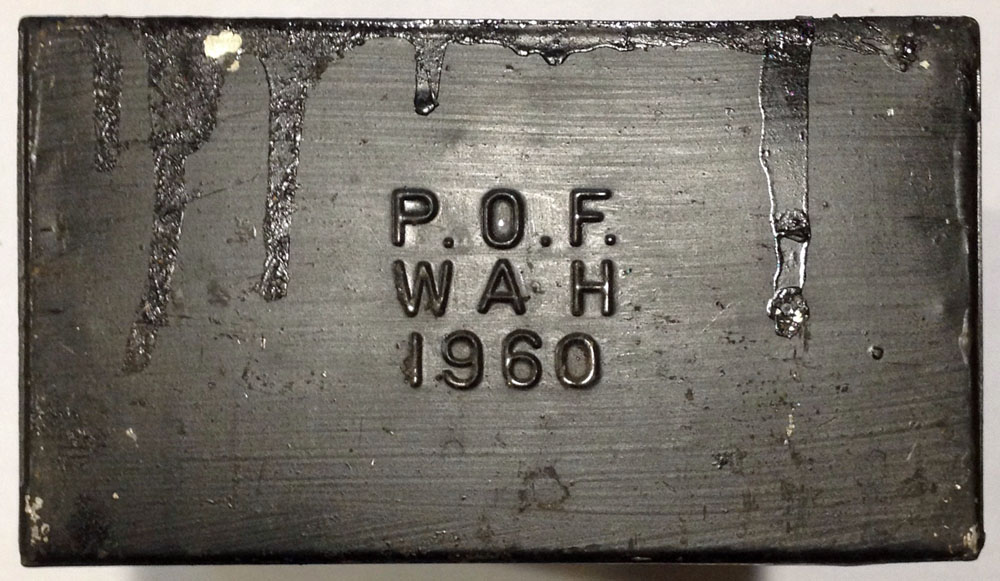 by
giving a sharp pull. Another label
includes the lot number (20/60) and the date the tin was
packed, which
matches the 11
10 60 date by
giving a sharp pull. Another label
includes the lot number (20/60) and the date the tin was
packed, which
matches the 11
10 60 date
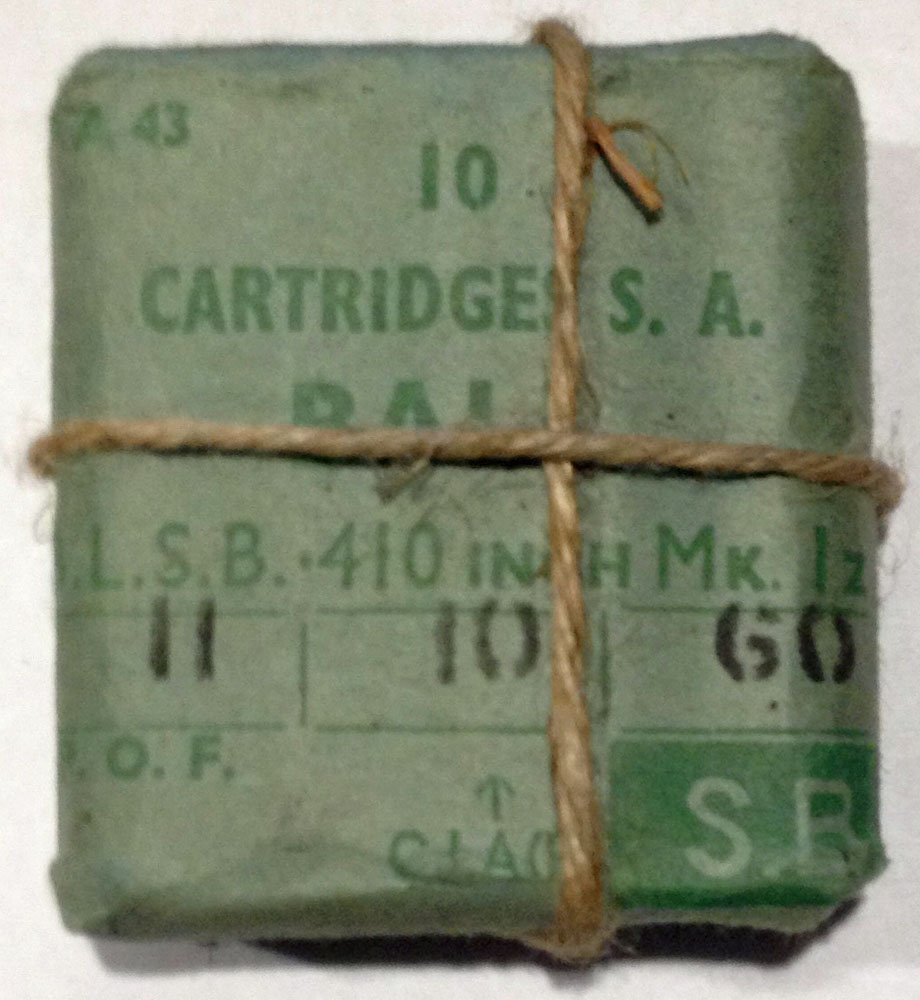 stenciled
on the end of the crate. The tin contains 18 string
tied 10 round green paper packs of cartridges
labeled 10 /
CARTRIDGES
S.A. / BALL / B.L.S.B .410 INCH MK. 1z / 11 10 60 / P.O.F.
C.I.A.(P) with a large S.B. on a green background. stenciled
on the end of the crate. The tin contains 18 string
tied 10 round green paper packs of cartridges
labeled 10 /
CARTRIDGES
S.A. / BALL / B.L.S.B .410 INCH MK. 1z / 11 10 60 / P.O.F.
C.I.A.(P) with a large S.B. on a green background.
These cartridges were made to be used in production .303
Lee-Enfield rifle that were converted to single shot
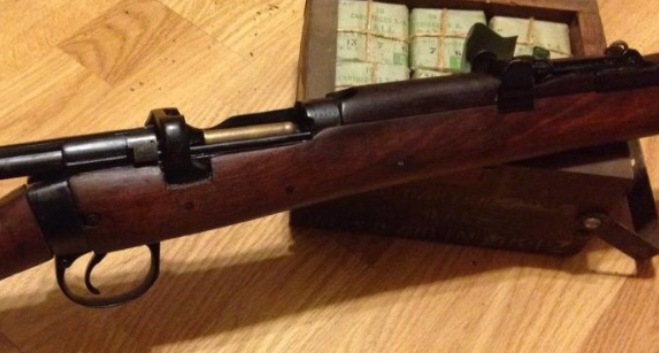 muskets
by boring out the barrels, modifying the forward portion of the chambers to
accept the un-necked .303 case that was used for the .410 Mark I
single ball cartridge, and filling the magazine well in the stock with a
wood plug. Thousands of these muskets were made up at muskets
by boring out the barrels, modifying the forward portion of the chambers to
accept the un-necked .303 case that was used for the .410 Mark I
single ball cartridge, and filling the magazine well in the stock with a
wood plug. Thousands of these muskets were made up at
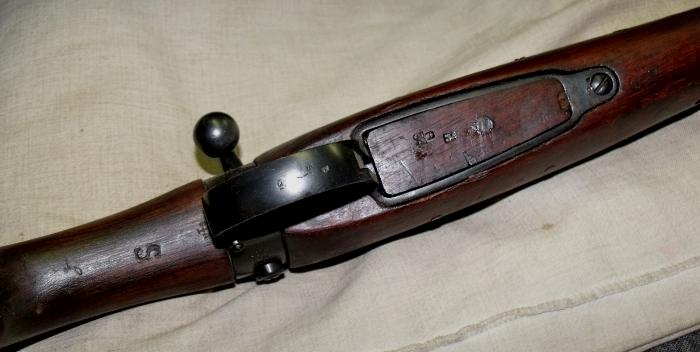 the
rifle factory in Ishapore, India beginning in the early 1930s. The cartridges in my packets are in pristine condition,
and would likely be shootable, if I only had one of the converted Enfield
rifles to give them a try. These cartridges would be a very loose fit in the
chamber of a standard .410 shotgun and it would be dangerous to attempt to
use them in a gun for which they were not intended. the
rifle factory in Ishapore, India beginning in the early 1930s. The cartridges in my packets are in pristine condition,
and would likely be shootable, if I only had one of the converted Enfield
rifles to give them a try. These cartridges would be a very loose fit in the
chamber of a standard .410 shotgun and it would be dangerous to attempt to
use them in a gun for which they were not intended.
 The
headstamp on these cartridges is POF 60 410 IZ, indicating
that they were made at the Pakistan Ordnance Factory The
headstamp on these cartridges is POF 60 410 IZ, indicating
that they were made at the Pakistan Ordnance Factory
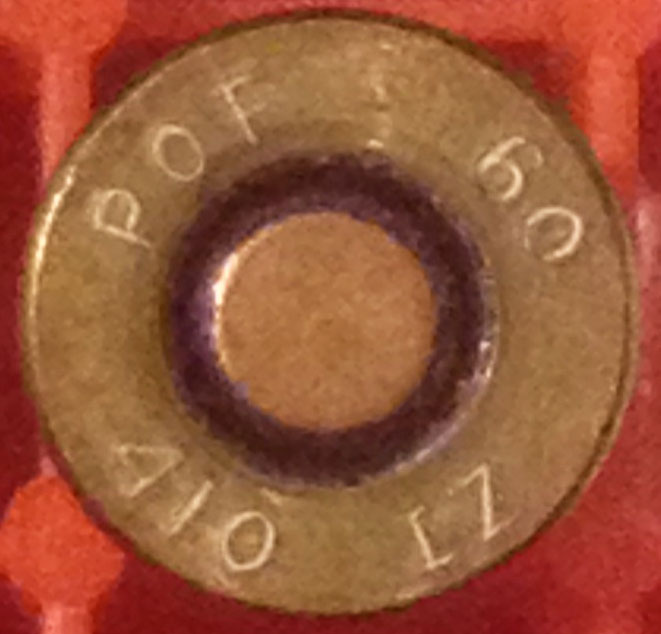 at
Rawalpindi, Pakistan in 1960. Packing dates on crates that are pictured at
various sites on the internet range from April through October of 1960, and
all of those that included a photo of the headstamp matched those in my
crate. at
Rawalpindi, Pakistan in 1960. Packing dates on crates that are pictured at
various sites on the internet range from April through October of 1960, and
all of those that included a photo of the headstamp matched those in my
crate.
After a great deal of pounding with my inertia bullet
puller, I was able to force the ball past the case mouth crimp and get the
components out of the case. As advertised, there was a single round ball, in
addition to three thin card wads, felt wads in three different thicknesses,
and a charge of small, round, flat grain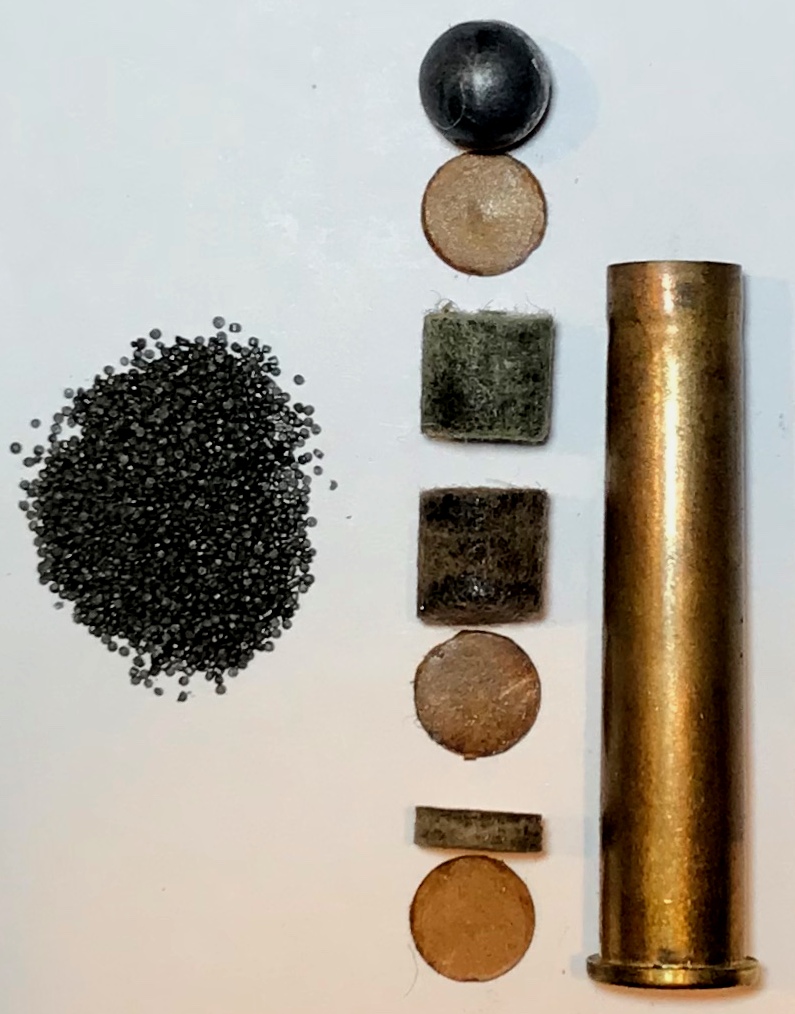 s
of nitro-cellulose powder. s
of nitro-cellulose powder.
.
.
.
.
.
Sources:
General information from Wikipedia, Lee-Enfield, Muskets and Shotguns -
https://en.wikipedia.org/wiki/Lee%E2%80%93Enfield#Muskets_and_Shotguns
International Ammunition Association General Ammunition Discussion topics
-
https://forum.cartridgecollectors.org/t/0-410-single-ball-mk-1-z-p-o-f-1960-production/15075
https://forum.cartridgecollectors.org/t/410-indian-musket/15575/2
https://forum.cartridgecollectors.org/t/british-410-ammunition-crate/16195/9
.
.
.
.
.
.
.
.
.
.
.
.
.
.
.
.
.
.
.
.
.
.
.
.
.
.
.
.
.
.
.
.
.
.
.
.Sources:
.
.Return to Home
Page
.
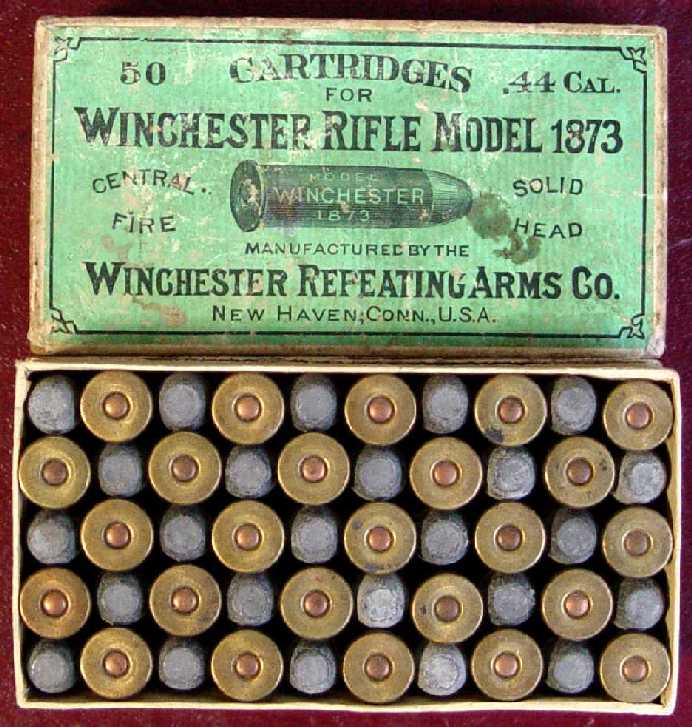
|

 Nonetheless,
a couple of anti-tamper measures are used on the crate that will provide an indication that it has been opened. These are shown in the photo
here and the two just below. The first of these anti-tamper measures is a plug of a red
crumbly plastic-ish material (wax?) that fills a shallow 1.75" diameter hole
drilled into the top of the crate. It secures a brass latch-like arm which
is attached to one of two metal straps that hold the ends of top of the
crate securely in place. Once the red plug is broken, the arm is
Nonetheless,
a couple of anti-tamper measures are used on the crate that will provide an indication that it has been opened. These are shown in the photo
here and the two just below. The first of these anti-tamper measures is a plug of a red
crumbly plastic-ish material (wax?) that fills a shallow 1.75" diameter hole
drilled into the top of the crate. It secures a brass latch-like arm which
is attached to one of two metal straps that hold the ends of top of the
crate securely in place. Once the red plug is broken, the arm is
 freed
and the end strap that it is attached to can be pivoted outward, freeing
that end of the top and allowing the lid to slide out from under the
other end strap. In the process of removing the top, two strips of cloth,
one attached to each end of the top and a short distance down each side of
the crate, would have to be cut or would tear
freed
and the end strap that it is attached to can be pivoted outward, freeing
that end of the top and allowing the lid to slide out from under the
other end strap. In the process of removing the top, two strips of cloth,
one attached to each end of the top and a short distance down each side of
the crate, would have to be cut or would tear
 free,
providing another indication that the crate had been opened. These cloth
strips are
white; one
is marked in black PA802 C.I.A.(P), and the other is marked in black PA803 P.O.F..
I'm not sure what the C.I.A.(P) is, but the P.O.F. indicates the ammunition
was produced at the Pakistani Ordnance Factories.
free,
providing another indication that the crate had been opened. These cloth
strips are
white; one
is marked in black PA802 C.I.A.(P), and the other is marked in black PA803 P.O.F..
I'm not sure what the C.I.A.(P) is, but the P.O.F. indicates the ammunition
was produced at the Pakistani Ordnance Factories.
 One end end of the crate is stenciled LOT 20 / 60, which
would mean that this is the 272nd box (as stenciled on top of the crate)
from the 20th of 60 lots of this ammunition. The highest numbered crate I
have seen in my Googling the internet was 571. Also stenciled on that end is
P.O.F. 11.10.60 which indicates the crate was packed at the Pakistani
Ordnance Factories on 11 October, 1960. The attached label with the 6 in a
red ball I assume is an explosives classification. The label is marked
GOVERNMENT EXPLOSIVE D.P.A. (with a British broad arrow mark over the P),
and SAFETY S
One end end of the crate is stenciled LOT 20 / 60, which
would mean that this is the 272nd box (as stenciled on top of the crate)
from the 20th of 60 lots of this ammunition. The highest numbered crate I
have seen in my Googling the internet was 571. Also stenciled on that end is
P.O.F. 11.10.60 which indicates the crate was packed at the Pakistani
Ordnance Factories on 11 October, 1960. The attached label with the 6 in a
red ball I assume is an explosives classification. The label is marked
GOVERNMENT EXPLOSIVE D.P.A. (with a British broad arrow mark over the P),
and SAFETY S IX
CARTRIDGES. The other end of the crate was originally unmarked, but has had
a white
import label attached for shipping purposes, indicating the contents are
United Nations dangerous explosive materials category 12 - cartridges for
weapons, inert projectiles.
IX
CARTRIDGES. The other end of the crate was originally unmarked, but has had
a white
import label attached for shipping purposes, indicating the contents are
United Nations dangerous explosive materials category 12 - cartridges for
weapons, inert projectiles.
 tear
off the lid
tear
off the lid
 by
giving a sharp pull. Another label
includes the lot number (20/60) and the date the tin was
packed, which
matches the 11
10 60 date
by
giving a sharp pull. Another label
includes the lot number (20/60) and the date the tin was
packed, which
matches the 11
10 60 date
 stenciled
on the end of the crate. The tin contains 18 string
tied 10 round green paper packs of cartridges
labeled 10 /
CARTRIDGES
S.A. / BALL / B.L.S.B .410 INCH MK. 1z / 11 10 60 / P.O.F.
C.I.A.(P) with a large S.B. on a green background.
stenciled
on the end of the crate. The tin contains 18 string
tied 10 round green paper packs of cartridges
labeled 10 /
CARTRIDGES
S.A. / BALL / B.L.S.B .410 INCH MK. 1z / 11 10 60 / P.O.F.
C.I.A.(P) with a large S.B. on a green background. muskets
by boring out the barrels, modifying the forward portion of the chambers to
accept the un-necked .303 case that was used for the .410 Mark I
single ball cartridge, and filling the magazine well in the stock with a
wood plug. Thousands of these muskets were made up at
muskets
by boring out the barrels, modifying the forward portion of the chambers to
accept the un-necked .303 case that was used for the .410 Mark I
single ball cartridge, and filling the magazine well in the stock with a
wood plug. Thousands of these muskets were made up at
 the
rifle factory in Ishapore, India beginning in the early 1930s. The cartridges in my packets are in pristine condition,
and would likely be shootable, if I only had one of the converted Enfield
rifles to give them a try. These cartridges would be a very loose fit in the
chamber of a standard .410 shotgun and it would be dangerous to attempt to
use them in a gun for which they were not intended.
the
rifle factory in Ishapore, India beginning in the early 1930s. The cartridges in my packets are in pristine condition,
and would likely be shootable, if I only had one of the converted Enfield
rifles to give them a try. These cartridges would be a very loose fit in the
chamber of a standard .410 shotgun and it would be dangerous to attempt to
use them in a gun for which they were not intended. The
headstamp on these cartridges is POF 60 410 IZ, indicating
that they were made at the Pakistan Ordnance Factory
The
headstamp on these cartridges is POF 60 410 IZ, indicating
that they were made at the Pakistan Ordnance Factory
 at
Rawalpindi, Pakistan in 1960. Packing dates on crates that are pictured at
various sites on the internet range from April through October of 1960, and
all of those that included a photo of the headstamp matched those in my
crate.
at
Rawalpindi, Pakistan in 1960. Packing dates on crates that are pictured at
various sites on the internet range from April through October of 1960, and
all of those that included a photo of the headstamp matched those in my
crate.